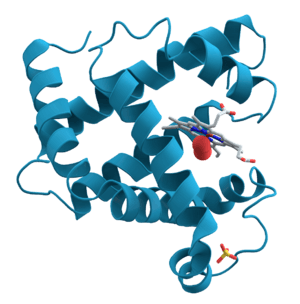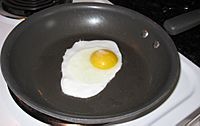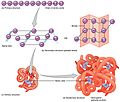Protein facts for kids

Proteins are long-chain molecules built from small units known as amino acids. They are joined together with peptide bonds.
They are biochemical compounds consisting of one or more polypeptides folded into a round or fibrous shape.
A polypeptide is a single linear polymer chain of amino acids. The sequence of amino acids in a polypeptide comes from the DNA sequence of a gene. The genetic code specifies 20 standard amino acids. Shortly after synthesis, some amino acids are chemically modified. This alters the folding, stability, activity, and function of the protein. Sometimes proteins have non-peptide groups attached, as cofactors.
Proteins are essential to all cells. Like other biological macromolecules (polysaccharides and nucleic acids), proteins take part in virtually every process in cells:
- Many proteins are enzymes that catalyze (help to happen) biochemical reactions and are vital to metabolism.
- Other proteins have structural or mechanical functions, such as in muscle and in cells. The cytoskeleton is a system of scaffolding that keeps cell shape.
- Other proteins are important in cell signalling, immune responses, and cell division.
Contents
Proteins for human beings
Proteins have different functions depending on their shape. They can be found in meat or muscle. They are used for growth and repair, as well as for strengthening the bones. They help to make tissue and cells. They are in animals, plants, fungi, bacteria, and also in the human body.
Muscles contain a lot of protein. When protein is digested, it is broken down into amino acids. These amino acids can then be used to build new protein. Proteins form an important part in foods like milk, eggs, meat, fish, beans, spinach, and nuts. There are four factors that determine what a protein will do. The first is the order of the amino acids. There are 20 different types of amino acids. The second is the little twists in the chain. The third is how the entire structure is folded up. The fourth is whether it is made up of different sub-units. Haemoglobin molecules, for example, are made of four sub-units.
Damaging mutations
Most proteins are enzymes, and mutations may slow them or stop them working. 50% of human cancers are caused by mutations in the tumour suppressor p53. p53 is a protein which regulates cell division.
Essential amino acids
Proteins are necessary in an animal's diets, since animals cannot make all the amino acids they need (they can make most of them). They must get certain amino acids from food. These are called the essential amino acids. Through digestion, animals break down ingested protein into free amino acids. The amino acids are then used in metabolism to make the enzymes and structures the body needs.
There are nine essential amino acids for humans, which are obtained from food. The nine essential amino acids are: histidine, isoleucine, leucine, lysine, methionine, phenylalanine, threonine, tryptophan, and valine. Meat contains all the essential amino acids humans need; most plants do not. However, eating a mixture of plants, such as both wheat and peanut butter, or rice and beans, provides all the essential amino acids needed. Soy products like tofu provide all the essential amino acids—as does quinoa—but these are not the only way to get the protein humans need.
The scientist Jöns Jacob Berzelius gave proteins their name, but many other scientists have studied proteins.
Related pages
Images for kids
-
John Kendrew with model of myoglobin in progress
-
Chemical structure of the peptide bond (bottom) and the three-dimensional structure of a peptide bond between an alanine and an adjacent amino acid (top/inset). The bond itself is made of the CHON elements.
-
Resonance structures of the peptide bond that links individual amino acids to form a protein polymer
-
The crystal structure of the chaperonin, a huge protein complex. A single protein subunit is highlighted. Chaperonins assist protein folding.
-
Three possible representations of the three-dimensional structure of the protein triose phosphate isomerase. Left: All-atom representation colored by atom type. Middle: Simplified representation illustrating the backbone conformation, colored by secondary structure. Right: Solvent-accessible surface representation colored by residue type (acidic residues red, basic residues blue, polar residues green, nonpolar residues white).
-
Molecular surface of several proteins showing their comparative sizes. From left to right are: immunoglobulin G (IgG, an antibody), hemoglobin, insulin (a hormone), adenylate kinase (an enzyme), and glutamine synthetase (an enzyme).
-
The enzyme hexokinase is shown as a conventional ball-and-stick molecular model. To scale in the top right-hand corner are two of its substrates, ATP and glucose.
-
Ribbon diagram of a mouse antibody against cholera that binds a carbohydrate antigen
-
Proteins in different cellular compartments and structures tagged with green fluorescent protein (here, white)
-
Constituent amino-acids can be analyzed to predict secondary, tertiary and quaternary protein structure, in this case hemoglobin containing heme units
See also
 In Spanish: Proteína para niños
In Spanish: Proteína para niños









